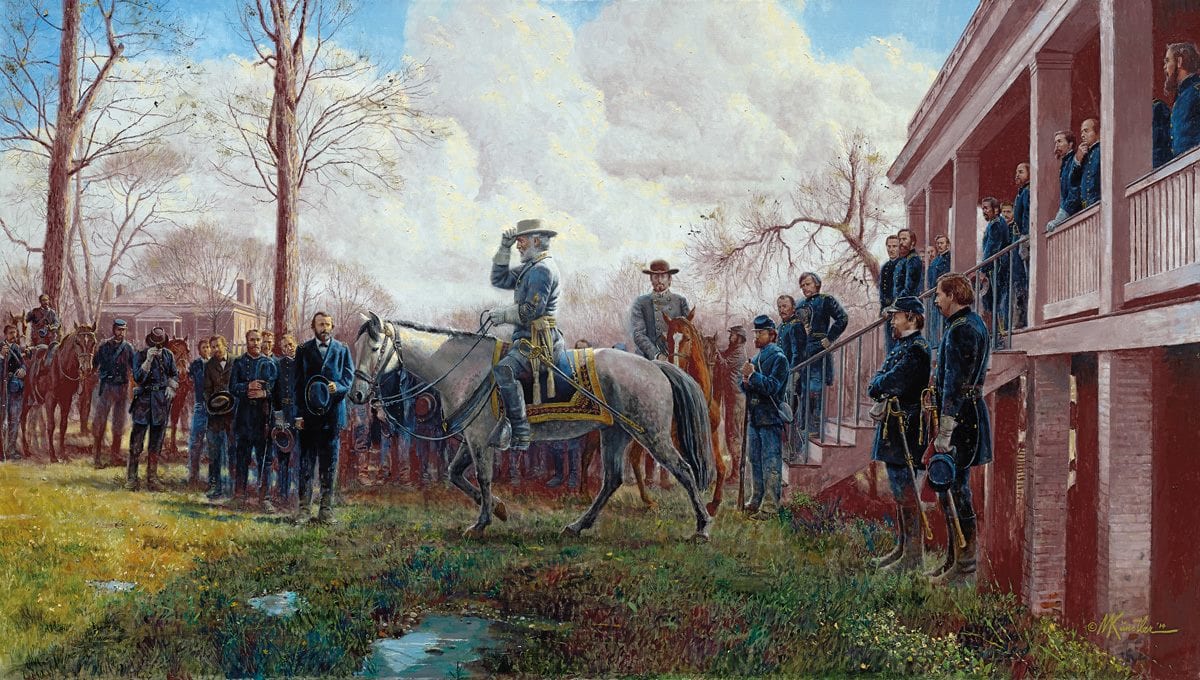Table Of Content

As for casualties from this fight, there are no Confederate reports, so the exact total will never be know—perhaps 100 men killed and wounded in some manner, but nearly 1,000 Confederate soldiers captured, including Brigadier General Young Moody, and about 100 wagons. Federal casualties totaled less than 50, but Union surgeons commented that they “had never treated so many extreme cases in so short a fight. The wounds were chiefly made by artillery, and were serious; many patients being badly mangled." Some of the discharges of canister found their mark, taking down horses and men, one of them being a future Governor of Vermont, Charles J. Bell, with an iron ball lodged in the back of his hand. In the swirl of fighting, the color bearer of the Washington Artillery of New Orleans, William Davis, “A splendid soldier,” was killed staining the flag with his life blood. The soldiers of the Army of Northern Virginia were issued parole passes for safe passage home, free food and free transportation.
Facts: The Continental Army
While generally, the trend was that either Lincoln or Stephen Douglas won the more populated counties while John Breckinridge took the more rural ones, the details are more complex. The WRA provides no financial assistanceto evacuees going out on student leave. April is a month marked by significant dates in Civil War history – most significantly, Confederate Gen. Robert E. Lee’s surrender to Union Gen. Ulysses S. Grant on April 9, 1865, at Appomattox Court House in Virginia. However, more surrenders were needed for the war to truly be brought to an end.
A Tearful Farewell at the Stacking of Arms
They include the locations of Lee’s and Grant’s headquarters, which are at the east and west sides of the park, respectively. Meanwhile, to the north of Appomattox Court House, the Federal 2nd Corps was moving against Major General James Longstreet’s 1st Corps. Realizing that his army was trapped, Lee contacted Lieutenant General Ulysses S. Grant asking for terms of surrender.
Auto Driving Tour of Civil War Lynchburg
Operating Hours & Seasons - Appomattox Court House National Historical Park (U.S - National Park Service
Operating Hours & Seasons - Appomattox Court House National Historical Park (U.S.
Posted: Tue, 05 Sep 2023 07:00:00 GMT [source]
On March 25, 1865, Lee made one final attempt to break the Siege of Petersburg by ordering forces commanded by Major General John B. Gordon to attack Fort Stedman, a Union fortification in the siege lines surrounding Petersburg. Gordon’s pre-dawn attack was successful initially, but blistering Union counterattacks forced the Confederates back inside their lines, ending the Battle of Fort Stedman. The Appomattox Court House National Historical Park is the preserved 19th-century village named Appomattox Court House in Appomattox County, Virginia. The village was named for the presence nearby of what is now preserved as the Old Appomattox Court House.

United again, these common everyday objects—a red striped towel, a couple of chairs, and a side table—document an extraordinary moment in history, when the Civil War effectively came to an end, and, though dramatically remade, the nation would be preserved. Many within the Union considered Confederates traitors who were personally responsible for this tremendous loss of lives and property. Lee’s own army had threatened the nation’s capital and had to be driven back in some of the bloodiest battles of the war. Healing the country, rather than vengeance, directed Grant’s and the Lincoln administration’s actions. There would be no mass imprisonments or executions, no parading of defeated enemies through Northern streets.
Edit My Account
A fourth train which had just arrived, started back for Lynchburg in such a rush that it broke some of the couplings and left most of its cars behind. Walker drew his men into a semi-circle and was supported by the only troops in the vicinity, Talcott’s Engineers (acting as infantry), General Martin Gary’s Cavalry Brigade (7th South Carolina, 7th Georgia, 24th Virginia), and 75 to 100 artillerymen acting as infantry. On April 8 Lee’s Army of Northern Virginia paused its march a mile from the small village of Appomattox Court House. Lee intended to resupply there before heading to Lynchburg, Virginia, and then south to Danville, Virginia.
Through the lenient terms, Confederate troops are paroled and allowed to return to their homes while Union soldiers are ordered to refrain from overt celebration or taunting. These measures serve as a blueprint for the surrender of the remaining Confederate forces throughout the South. Rather than destroy his army and sacrifice the lives of his soldiers to no purpose, Lee decided to surrender the Army of Northern Virginia.
Park development history
Officers would keep their side arms, and Lee’s starving men would be given Union rations. With no remaining options, Lee sent a message to General Ulysses Grant announcing his willingness to surrender the Army of Northern Virginia. The two war-weary generals met on April 9, 1865 in the front parlor of the Wilmer McLean home at one o’clock that afternoon. The Battle of Appomattox Court House was fought on April 9, 1865, near the town of Appomattox Court House, Virginia, and led to Confederate General Robert E. Lee’s surrender of his Army of Northern Virginia to Union General Ulysses S. Grant. Days earlier, Lee had abandoned the Confederate capital of Richmond and the city of Petersburg; his goal was to rally the remnants of his beleaguered troops, meet Confederate reinforcements in North Carolina and resume fighting. But the resulting Battle of Appomattox Court House, which lasted only a few hours, effectively brought the four-year Civil War to an end.
Confederate desertions were mounting daily, and by April 8 the Rebels were almost completely surrounded. Nonetheless, early on the morning of April 9, Confederate troops led by Major General John B. Gordon mounted a last-ditch offensive that was initially successful. Soon, however, the Confederates saw that they were hopelessly outnumbered by two corps of Union soldiers who had marched all night to cut off the Confederate advance.
Lee realized that the day was lost and he advised President Jefferson Davis to prepare to leave the Confederate capital at Richmond. On March 29, Major General G.K. Warren’s 5th Corps defeated several Confederate brigades commanded by Major General Bushrod Johnson at the Battle of Lewis’s Farm. Two days later, the action resumed at the Battle of White Oak Road and Battle of Dinwiddie Court House as Lee shored up his right-wing to halt the federal flanking maneuver. While Lee’s surrender at Appomattox Court House marked the end of the war in Virginia, it was not the end of the Civil War as a whole. Johnston’s Army of Tennessee was still being chased by Union Gen. William Tecumseh Sherman. Smaller Confederate armies continued to fight throughout the Deep South and west of the Mississippi River.
The Union Army of the Potomac relentlessly engaged the Confederate Army of Northern Virginia throughout the spring of 1864. Thereafter, both armies were entrenched, and a stalemate ensued for the next ten months. Despite being well-entrenched, the Confederate situation grew progressively worse as their supplies dwindled.
A small foray west of the village was made by 25 men of the 4th and 14th North Carolina Infantry as a delaying action, while the remainder of Gordon’s Corps retreated and reformed on the east side of the shallow Appomattox River. Grant, aware that Lee's army was out of options, had written to Lee on April 7, requesting the Confederate general's surrender. But Lee still hopes to access more supplies further west at Lynchburg and does not capitulate.
As the Confederates continued their approach, the 69th unleashed a heavy fire upon the grey ranks. Having stockpiled weapons, many of the soldiers of the 69th had six to eight loaded rifles leaning against the wall, ready to be fired. Eighty yards east of the Angle stood the 72nd Pennsylvania, which had just been moved forward from its reserve position. The 72nd Pennsylvania assisted the 69th with a heavy line of fire, and the two regiments of the California Brigade effectively blocked further advance from Armistead’s brigade. On July 3rd, the California Brigade was charged with defending the Angle during Pickett’s Charge. The Confederate effort against the Angle was greater than any other part of the line.
Reconciliation after the war would not be as easy or painless as many of the individuals who crowded into the McLean parlor on that spring day had hoped. While finding a path to reunite the nation might have been the goal of some, others turned to the struggle over political, social and economic power in the post-war era that saw tremendous and far-reaching changes. Reconstruction was a slow and at times violent undertaking, and Lincoln’s wish that the nation shall have a new birth of freedom would largely be deferred. The Union was saved, but the intersections of race and legacy of slavery, which was at the core of the Civil War, continues to confront Americans today. Over McLean’s objections, Union officers snapped up his furniture as trophies, leaving behind gold coins as payment. General Sheridan took the side table, Brigadier General Henry Capehart removed Grant’s chair, and Lieutenant Colonel Whitaker obtained Lee’s.
There were still reports of minor skirmishes coming in, but those, too, would soon be brought under control. President Lincoln’s second term was underway, and many hoped his second term would be a substantially happier and much more peaceful one. That happiness soon took a quick turn with the news that President Lincoln had been shot…. Though many in the Union considered Confederates traitors, believing them “personally responsible for this tremendous loss of lives and property” and wanting to see them punished severely, not all Northerners felt this way. Grant’s terms of surrender and the Lincoln administration’s actions were focused on “healing the country, rather than vengeance….
A negotiated departure of Texas from the U.S. would likely require negotiations over “enormous amounts” of federal money spent on military bases, infrastructure and engineering that made parts of Texas habitable, Finkelman said. James Wilets, a law professor at Shepard Broad College of Law at Nova Southeastern University, said the Constitution is silent on the issue of secession, but Texas v. White is clear there is no such right. "Almost no lawyer would take that argument seriously," said Sanford Levinson, a government professor at the University of Texas School of Law. The role of the state of California is often seen as inconsequential to the momentous events of the Civil War occurring thousands of miles east. However, despite its distance from the larger conflict, California reflected the sectional division of the period.

No comments:
Post a Comment